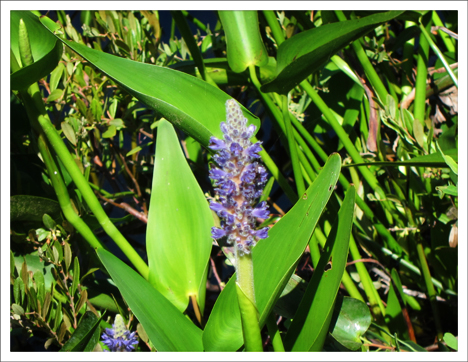Adirondack Wildflowers:
Pickerelweed (Pontederia cordata)
 Adirondack Wildflowers: Pickerelweed on Heron Marsh at the Paul Smiths VIC (5 July 2011)
Adirondack Wildflowers: Pickerelweed on Heron Marsh at the Paul Smiths VIC (5 July 2011)
| This page is no longer being updated. For an updated and expanded version of this material, see: Pickerelweed (Pontederia cordata) |
Pickerelweed is an aquatic plant which flourishes in the shallow borders of ponds and streams in the Adirondack Mountains. The plant produces showy purple-blue flowers in July and August. The flowers are arranged in a spike up to six inches long and bloom in succession from the bottom up. The flowers are pollinated by bees The plant is one to four feet tall, with heart-shaped green leaves.
Pickerelweed is typically found in quiet, shallow water, such as Marshes and the borders of muddy ponds. Pickerelweed grows in eastern north America, Nova Scotia to Florida and Texas.
Pickerelweed reportedly has been used for food. Both the leaves and the seeds are said to be edible. The seeds, which reportedly have a nutty flavor, can be eaten like nuts straight from the plant or dried and added to cereal. The young leaf-stalks have sometimes been eaten raw in salads, cooked like spinach, or added to soups. Some native American tribes have used the plant as a contraceptive.
 Adirondack Wildflowers: Pickerelweed on Heron Marsh
at the Paul Smiths VIC (28 June 2012).
Adirondack Wildflowers: Pickerelweed on Heron Marsh
at the Paul Smiths VIC (28 June 2012).
Pickerelweed blooms in profusion on Heron Marsh at the Paul Smiths VIC and may be seen from the Heron Marsh Trail, the Boreal Life Trail, and the Silviculture Trail. This plant may also be seen by the Black Pond Trail, near the trail head on Keese Mill Road. Pickerelweed usually begins blooming in June at the VIC.
References
- Lady Bird Johnson Wildflower Center. Native Plant Database.
- United States Department of Agriculture. Plants Database.
- Plants for a Future. Database.
- Flora of North America. Plant Database.
- University of Michigan. Native American Ethnobotany. A Database of Foods, Drugs, Dyes and Fibers of Native American Peoples, Derived from Plants.
- Anne McGrath.
Wildflowers of the Adirondacks (EarthWords, 2000), p.
92.
- Doug Ladd. North Woods Wildflowers (Falcon Publishing, 2001), p. 58.
- Lawrence Newcomb. Newcomb's Wildflower Guide (Little Brown and Company, 1977), pp. 50-51.
- Roger Tory Peterson and Margaret McKenny. A Field Guide to Wildflowers. Northeastern and North-central North America (Houghton Mifflin Company, 1968) pp. 316-317.
- National Audubon Society. Field Guide to Wildflowers. Eastern Region. (Alfred A. Knopf, 2001), pp. 706-707.
- William K. Chapman, et al. Wildflowers of New York in Color (Syracuse University Press, 1998), pp. 126-127.
- Donald D. Cox, A Naturalist's Guide to Wetland Plants. An Ecology for Eastern North America (Syracuse University Press, 2002), pp. 62,69,171.
